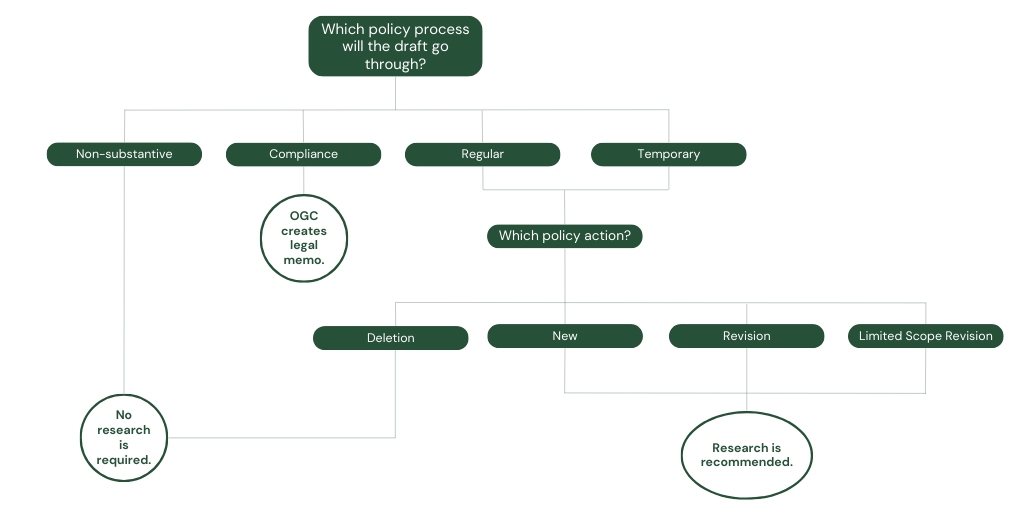When encouraged or appropriate, drafting committees must ensure all content in policy drafts accurately complies with laws, best practices, and industry standards. Thus, as part of the policy drafting process, drafting committees may need to conduct research for their policy draft. Conducting policy research as needed will not only improve the quality of university policy but will also better inform and protect the university community at large as well as create a more efficient drafting process.
The policies that will benefit most from research are policies that cannot enter the temporary policy process as identified in Policy 101 (policies regarding compensation, retention, tenure, promotion, performance review, or academic freedom), that involve due process, or that address individual rights. To determine if a draft benefits from research, please refer to the decision tree below:

If the drafting committee determines it needs to conduct research, proceed to Step 1: Preapproval below.
If a policy draft involves legal research, the Office of General Counsel will create a legal memo. This is most often done in the compliance change process.

 Step 1 Preapproval
Step 1 PreapprovalAnswer the research-related questions on the Executive Summary Form:
1. Will policy research be conducted for this draft?
Check Yes or No to answer this question (Refer to the Decision Tree to help you answer this question). If the answer is no, you do not need to answer the remaining questions.
2. Will you use the Policy Office’s standard Policy Research Template?
Check Yes or No to answer this question. The Policy Research Spreadsheet Template is an Excel spreadsheet that helps to organize and track policy research. It lists UHSE institutions, IPEDS institutions (those identified as peer institutions), and a few institutions that have exemplary policy manuals; this allows the drafting committee to see how other institutions may have implemented policies like the one being drafted and researched. However, this template may not be useful in some policy research areas; drafting committees may determine to use a different methodology. To learn more about the Policy Research Spreadsheet Template, please refer to Using the Policy Research Templates.
3. What research benchmarks will be used?
These anticipated benchmarks will be the standard all the research is compared against. Benchmarks may be derived from any of the following resources:
The policy steward and sponsor submit the completed Executive Summary Form to the Policy Office. Once the Policy Office approves the Executive Summary Form, the Policy Office and the policy owners submit the form to President’s Council for their approval to enter Stage 1.
 Step 2 Research
Step 2 ResearchWhen the policy enters Stage 1, policy stewards and their drafting committees can begin research (if they haven’t already) and drafting. To assist in this process, the Policy Office will create a Teams channel for the draft and upload templates and documents that the drafting committee will need. Among these templates will be the Research Memo Template and Policy Research Spreadsheet Template (see Using the Policy Research Templates).
Because research can be time consuming, drafting committees need to plan for the time needed for research as they establish their policy development timeline. The embedded editor can help develop this timeline. The Policy Office suggests one to three months for conducting research, though some policies may require more research time.
The drafting committee can research other existing policies, best practices, or laws and compare them with the identified benchmarks. Here are some tips and resources that may be helpful:
 Step 3 Research Memo and Submit for Approval
Step 3 Research Memo and Submit for ApprovalOnce the drafting committee completes their research, they will create a research memorandum (memo). This research memo summarizes the purpose of the research, explains the benchmarks used, uncovers the key findings, provides suggestions for the drafting committee if necessary, and lists the researched sources. Refer to the Research Memo Template and Using the Policy Research Templates for more information about how to write this memo.
In any disputes over research between the policy steward and the writing committee,
the steward prevails. The steward may choose to deviate from the research findings
when there is a compelling reason to do so. If the deviations involve any legal questions,
they must be done in collaboration with the Office of General Counsel. These deviations
and the reasons for them should also be recorded in the research memo.
Once completed, the research memo file will be submitted with the final Stage 1 draft
file to the Policy Office. The Policy Office will do an editorial review of the memo
and the policy draft, working with the policy steward to finalize it. The finalized
research memo and policy draft will then be submitted to the policy subcommittee and
President’s Council for approval.
When the policy enters Stage 2, the research memo will be included in the email to shared governance groups (Academic Affairs Council, Faculty Senate, PACE, and UVUSA) and EAC. The research memo will also be linked in the Policy Office news blog post announcing the change. Shared governance entities and the EAC may find the research memo useful as they conduct their review of the Stage 2 policy draft; this may help them understand the requirements influencing a new policy or revisions made to an existing policy.
If the drafting committee wants to customize the template for their own use, they are more than welcome to. Use and modify the template so it best serves the drafting committee’s research needs.
The research spreadsheet template has two sheets: “Research (H)” and “Research (V).” These two sheets are identical except for the organization. “Research (H)” lists the research benchmarks horizontally across the top while “Research (V)” lists the research benchmarks vertically along the left side. Choose the spreadsheet that makes the most organizational sense for the policy research being conducted.
This spreadsheet will be where all primary research is conducted. One axis of the chart lists all the research benchmarks while the other axis lists all the institutions being analyzed (USHE schools and IPEDS peer institutions are listed in the template). This spreadsheet can help drafting committees analyze other policies to identify very specific details or benchmarks, which provides a better understanding of what information policies at similar institutions contain.
Once policy research is completed, that research must be summarized in a research memo. A research memo is necessary to convey why the drafting committee made certain decisions in the policy draft and what sources influenced these decisions. This template contains the following sections:
Please adhere to the memo template as much as possible. Your Policy Office embedded editor can assist with the creation of this memo.
Across the different policy processes and drafting committees, even though they use the same templates, the resulting documents may vary quite a bit in their final form because of the nature of their research, how they decided to present the information, or because of template customization. As always, you can consult the Policy Office embedded editor for insights on how to best customize these template documents.
Below are some previously completed research spreadsheets and research memos provided as examples for the drafting committee.
Policy 607 Course Fees Research
Policy 640 Faculty Sabbatical Leave Research
Policy 644 Department Chair Research